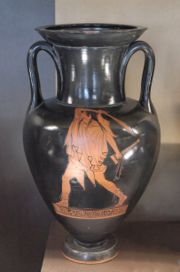
Providence Painter
Encyclopedia

Attica
Attica is a historical region of Greece, containing Athens, the current capital of Greece. The historical region is centered on the Attic peninsula, which projects into the Aegean Sea...
red-figure
Red-figure pottery
Red-figure vase painting is one of the most important styles of figural Greek vase painting. It developed in Athens around 530 BC and remained in use until the late 3rd century BC. It replaced the previously dominant style of Black-figure vase painting within a few decades...
style. He was active around 470 BC.
The Providence Painter is considered to have been a pupil of the Berlin Painter
Berlin Painter
The Berlin Painter is the conventional name given to an Attic Greek vase-painter who is widely regarded as a rival to the Kleophrades Painter, among the most talented vase painters of the early 5th century BCE .The Berlin Painter along with the Kleophrades Painter was educated by a member of the...
. His reputation is that of a careful artist at the transition from Archaic to Classical
Classical Greece
Classical Greece was a 200 year period in Greek culture lasting from the 5th through 4th centuries BC. This classical period had a powerful influence on the Roman Empire and greatly influenced the foundation of Western civilizations. Much of modern Western politics, artistic thought, such as...
art. He had difficulties shedding Archaic habits. For example, he tended to faithfully follow Archaic traditions in depicting anatomical detail or clothing. Short narrative scenes are known only from some of his larger vases, such as stamnoi
Stamnos
A stamnos is a type of Greek pottery used to store liquids. It is much squatter than an amphora and has two stubby handles relatively high on its sides. It is a relatively unusual container form. Generally, it was used for mixing and storing....
and hydria
Hydria
A hydria is a type of Greek pottery used for carrying water. The hydria has three handles. Two horizontal handles on either side of the body of the pot were used for lifting and carrying the pot. The third handle, a vertical one, located in the center of the other two handles, was used when...
i depicting groups of deities or mythical events. Usually, however, he painted smaller vases, such as Nolan amphorae or lekythoi
Lekythos
A lekythos is a type of Greek pottery used for storing oil , especially olive oil. It has a narrow body and one handle attached to the neck of the vessel. The lekythos was used for anointing dead bodies of unmarried men and many lekythoi are found in tombs. The images on lekythoi were often...
. One of his favourite motifs are women under pursuit. Generally, he usually depicts women as running or rushing. He also frequently uses scenes of domestic women,such as weaving. The Providence Painter is often found of using Athena and Nike (winged woman). Details of his paintings, such as eyes, earrings, ankles or certain plant ornaments are reminiscent of the Berlin Painter
Berlin Painter
The Berlin Painter is the conventional name given to an Attic Greek vase-painter who is widely regarded as a rival to the Kleophrades Painter, among the most talented vase painters of the early 5th century BCE .The Berlin Painter along with the Kleophrades Painter was educated by a member of the...
. Several of his vases carry a kalos inscription
Kalos inscription
The Kalos inscription was a form of epigraph found on Attic vases and graffiti in antiquity, common between 550 and 450 BC, and usually found on symposion vessels. The word καλός means "beautiful"; here it had an erotic connotation, and the inscription took the form of a youth's name, in the...
dedicated to Glaukon. The Providence takes his name from a big neck amphora depicting Apollo located in Providence Rhode Island.
Although the Providence painter focused on Lekythoi, he did create some amphora’s, perhaps because his teacher, the Berlin painter decorated a series of amphora’s in his middle period and during this phase the Providence painter learned from the Berlin painter. The Berlin Painter was also the first potter to popularize the use of red-figure on smaller pots, such as the lekthoi, as the Providence Painter has done. The Providence Painter also followed his master with the use of his distinctive symmetrical meander pattern. The Providence Painter mirrored many aspects of the Berlin Painter, suggesting he worked for some time in the Berlin painter’s workshop. But, unlike his master, the Providence painter used white ground with outline drawing on some of his smaller vases, a popular technique of lekythoi pottery.
The Providence painter can also be compared to Hermonax, a red-figure Athens painter active between 470 and 440 BC. Hermonax may have also been in the same workshop as the Berlin and Providence painters, as he shows many similarities. Hermonax is seen as the lesser artist though, as his techniques are not as well executed. For example, he does not draw the meander patter as well as the Berlin and Providence painters.

